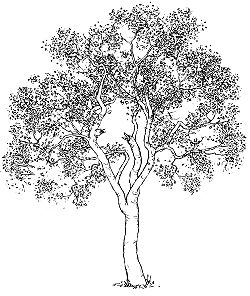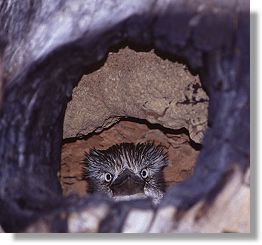Poplar gum and blue-winged kookaburra
| |
 |
Poplar Gum (Eucalyptus platyphylla) |
| |
The poplar gum (Eucalyptus platyphylla) dominates this unique woodland, with a lower shrub storey of Townsville wattle (Acacia leptostachya).
The poplar gum is a large tree up to 20 m in height with an open habit. It grows on the gentle foot slopes of the Island and on lower sandy soils with reasonable depth. The rounded leaves, like a poplar, and smooth white trunk, easily distinguish it from the other eucalypts.
The poplar gum flowers from August to October and, unusually for eucalypts, drops some of its leaves when flowering. In good years it may only lose a couple of leaves but in extraordinarily dry years it can drop its whole canopy. It then bursts into a magnificent display of white flowers, matched by a brilliant white trunk. As the poplar gum sheds its old bark it reveals a striking salmon pink bark, which returns to white after a couple of weeks.
Termites are responsible for the hollow-forming process in the eucalypts of northern Australia and are very important for the recycling of nutrients.
Due to the hollow nature of the trees, when major disturbances such as cyclones or fires occur, limbs are sheared or burnt off and fall to the ground. The fallen hollow logs on the ground provide habitat for many species, including reptiles and mammals, and the hollow in the trunk of the eucalypt now becomes a nesting place for various birds and mammals. This particular site provides a high density of poplar gums with an extensive network of hollows in a small area.
 |
Blue-winged Kookaburra (Dacelo leachii) |
The blue-winged kookaburra (Dacelo leachii), synonymous with the open woodland of tropical Australia, nests in the termite-formed hollows of these poplar gums. The blue winged kookaburra, with its raucous screaming call, is a member of the kingfisher family-a tropical species with deep blue on the wings of both sexes and on the males' tail.
The poplar gum woodland was once extensive throughout Nelly Bay. The majority of this woodland has now been cleared to provide increased residential and tourist development and infrastructure. A few old habitat trees are still represented on roadsides and in backyards.
Preservation of extended hollow tree woodlands and urban remnants is essential to the breeding viability of many species of birds and animals on the Island. Red- wing parrots, rainbow lorikeets, forest kingfishers, blue-wing kookaburras, sulphur-crested cockatoos and brush tail possums are all recorded as breeding in this woodland. |